How I Use AI System to Automate Entire Marketing Workflow to Grow My Newsletter
Clue: Vibe Marketing.
In the early stage of growing my newsletter, I was drowning.
Every Sunday morning, I'd sit at my desk with a growing sense of dread, staring at dozens different browser tabs: Reddit's AI subreddit, 30+ AI newsletters in my inbox, Tiktok/YouTube's endless stream of "AI tool of the week" videos, and my completely blank content calendar for the week ahead.
The amount of work required to stay relevant in the AI space and grow my newsletter was brutal. I needed to:
Monitor 50+ sources for trending topics
Create content for LinkedIn, Substack Notes, and my newsletter
Maintain my authentic voice across all platforms
Actually have original insights, not just regurgitate what everyone else was saying
The reality? I was spending my entire Sunday doing research, then scrambling all week to turn those insights into content with my perspective, not like every other AI creator saying the same things.
This frustrated me because I was so busy researching that I had no time left for the actual thinking and writing that made my content worth reading. I was working harder than ever but falling further with never-ending demand to keep up with AI trend every single week.
That's when I told myself:
“What if I could build AI systems that understood my unique perspective, my voice patterns, my strategic positioning? What if instead of replacing my judgment, AI could amplify it across social channels I didn't have time to manage manually?”
That question led me down a rabbit hole that changed my approach to growing my newsletter.
Today, I get that Sunday morning intelligence briefing automatically. But more importantly, I've figured out how to scale my newsletter growth alongside its authentic voice and strategic thinking across multiple platforms without losing what makes my content uniquely mine.
This is what I call "vibe marketing"—Using AI systems to manage and scale my entire marketing workflow while keeping what makes my content unique, not like every other AI creator—without adding significant amount of work.
This approach got me from 0 to 4K subscribers in four months, and I'm planning to scale it further to grow my newsletter from 4K to 10K+ subscribers and beyond while actually spending less time on content ideation, research, and distribution. Ultimately, I want to apply vibe marketing to the entire marketing cycle, but I need to take this step by step.
In this post, I'm sharing what I've learned so far to document my journey. Hopefully you can take away insights that you can apply both in your business and work.
But first, let me explain why this approach works now when it didn't work two years ago.
What's really happening in marketing
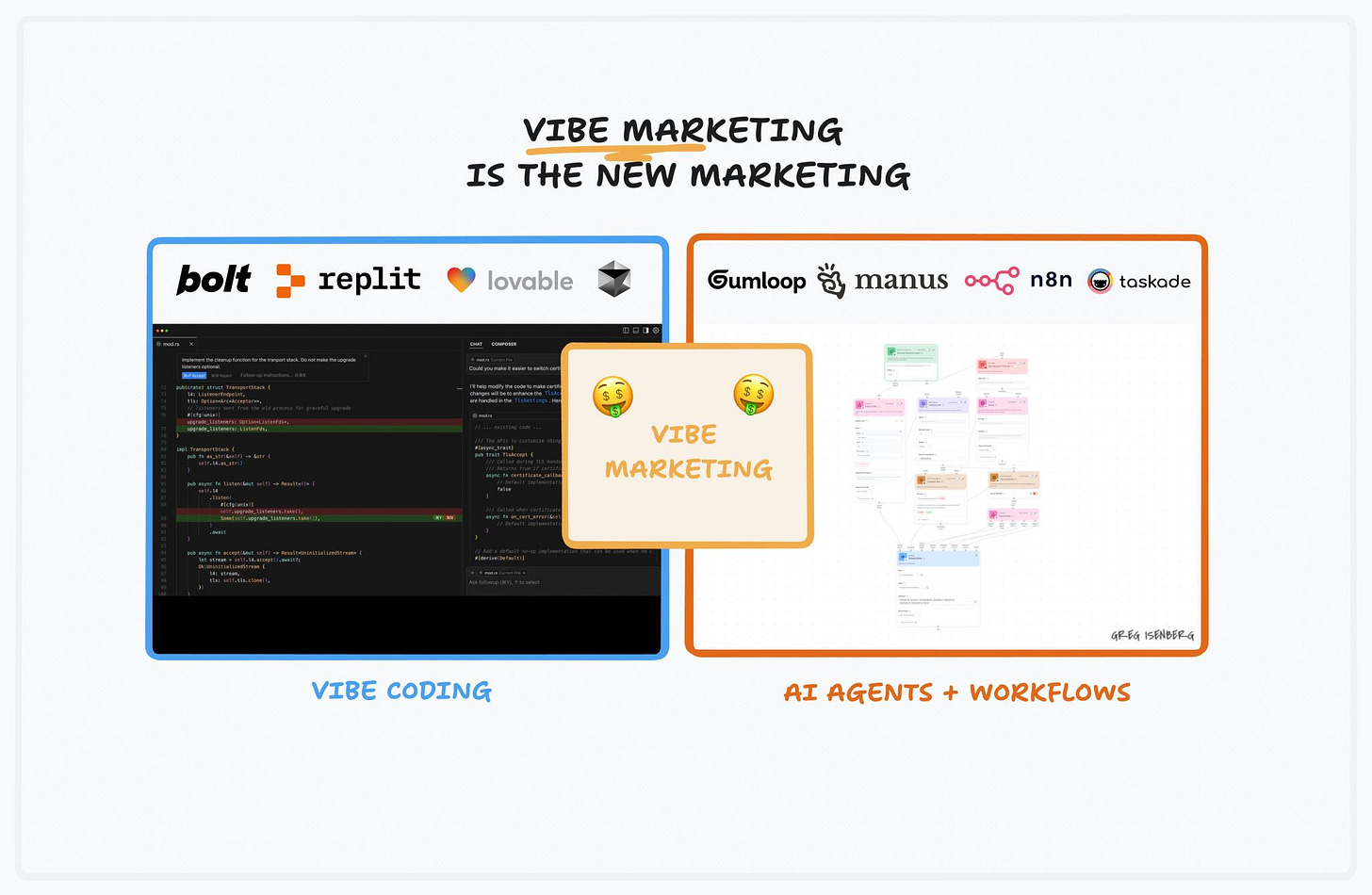
I know the term "vibe marketing" sounds like Silicon Valley nonsense—it reminds me of when "vibe coding" started to blow up. But after getting my hands dirty with this for six months, I've noticed something fundamental shifting in how people grow their businesses online, especially in marketing.
As AI becomes more agentic, there's a growing ecosystem of tools you can leverage to automate your marketing work—from ideation to execution—including Make, n8n, Zapier, Relay, Gumloop, Lindy, and more. By combining these with vibe coding principles for building web applications, you can create systems that let AI agents handle your marketing operations.
Today, you no longer need to hire agencies or do all the grunt work manually. You can direct these AI systems yourself—if you’re willing to learn the new skills.
The great marketing squeeze
Look at the meme—it perfectly captures what I've been seeing everywhere, from big companies to solo creators like me over the past 18 months.
People doing basic marketing tasks are getting squeezed out. Why hire someone to schedule social posts, repurpose content, or write email sequences when AI can do all that in minutes?
For example, I used to spend Sunday mornings manually scanning newsletters, draining time and mental energy that could've gone into developing better frameworks for future posts. Hours spent reformatting insights for different platforms meant missing chances to go deeper into topics that actually matter.
There's no middle ground in this new landscape. You either learn to direct AI systems for operational work, or you end up juggling both strategy and admin—meaning neither gets the focus it needs.
I realized I had a choice: keep competing with my own time limits, or build systems that amplify the work that truly requires my expertise.
That insight made me rethink my entire approach to growing my newsletter.
The five-part system I built to grow my newsletter with AI
This approach is what took my newsletter from zero to 4,000 subscribers in just four months. I'm planning to scale it even further—and I'll share more about that later on.
Ideation: Instead of manually scanning 30+ sources every Sunday, I built AI systems that monitor my industry and suggest content ideas that match MY specific expertise. Not "what's trending," but "what's trending that I could uniquely contribute to based on my experiments."
Research: AI gathers intelligence about topics, but filters everything through my strategic lens—what would interest my audience, what aligns with my testing experience, what challenges the hype I see everywhere else.
Content Creation: AI learned my voice patterns from my best-performing posts because I taught Claude everything about my newsletter (past posts, growth/content framework, audience desire and pain points, etc). When I write about AI tools, it sounds conversational and includes my failures. When I share frameworks, it maintains my "learning through experimentation" approach.
Distribution: One newsletter post becomes 10+ social media pieces that still sound like me across different platforms. My LinkedIn audience gets the professional framework version, my Substack Notes readers get the thoughtful story.
Analysis: Instead of just tracking views and likes, AI helps me identify what content actually converts readers into newsletter subscribers, then suggests how to create more content like that.
These systems amplify my judgment, not replaces it. Each insight I learn about AI turns into a newsletter deep-dive, LinkedIn frameworks, social posts, and fresh ideas—all while staying true to my brand and practical focus.
My actual vibe marketing system
Here's what I'm actually building—not some theoretical future, but the system I'm testing right now to scale my newsletter:
1. Content Intelligence Pipeline
I've deployed AI agents across email, Reddit, YouTube, and TikTok that don't just monitor trends—they filter everything through my established expertise and writing style.
Let me tell you how it works: Every Sunday at 7 AM, I get a digest in my inbox that says things like:
"Here's what the AI community is buzzing about, and here's how you could uniquely contribute to these conversations."
The key difference: The agents know the difference between generic "10 ChatGPT tips" content and topics that align with my anti-hype, experimentation-first approach.
For example, last week when everyone was writing about Claude Code, my system suggested: "Instead of another feature overview, write about your actual experiment trying to use it for newsletter research—including what failed and why."
That insight became my upcoming "I Tested Claude Code for Content Research (Here's What Actually Worked)" post, which I’m still preparing as I’m writing this.
But to be honest, setting this up inside my Make.com account was incredibly time-consuming because it required trial and error to teach the AI to deliver outputs exactly as I wanted.
If you want to learn how I built this, join as a Maker Labs member.
2. Automated Content Repurposing
The moment I publish a newsletter, my Firecrawl agent crawls the URL and transforms it into LinkedIn posts and Substack Notes—maintaining my voice patterns and framework thinking.
I'm not copying and pasting quotes anymore. The system understands how to adapt my long-form insights into platform-specific formats that still sound authentically like me.
Real example: My "Adversarial AI" newsletter automatically became:
LinkedIn post: "Here's how to reprogram your AI into your most valuable thinking partner."
Substack Note: "The people building stronger thinking habits today will be the ones making better decisions tomorrow."
Each piece maintains my conversational tone and focus on personal experimentation, but is formatted for different consumption patterns. However, this workflow handles 80% of the work—I still need to manually edit it before publishing on my social platforms.
Next challenge: To grow further, I need to expand my distribution channels to X and TikTok. Even though I'm bad at video (honestly, I hate being on camera), I'm trying to crack AI avatars or faceless video creation using HeyGen. My plan is to create video scripts based on my latest newsletter posts, turn them into videos, and post them on TikTok.
Will this work? No idea. But that's exactly the kind of experiment I'm willing to pursue.
Happy to learn from people who have nailed this workflow :)
3. Visual Content Generation
Through Claude MCP, I've connected GPT Image Generation (via Zapier MCP), Canva, and my Google Drive so I can generate newsletter images, thumbnails, and social graphics without leaving my writing flow.
If you've been reading AI Maker for a while, you know how obsessed I am with using Claude as my AI work hub across different tools.
Instead of spending 30 minutes per post searching for stock images or designing graphics, I describe what I need and the system handles the visual creation.
Current experiment: I'm building an image editing tool with Google's Nano Banana model to handle custom visual content at scale. The goal: zero manual design work while maintaining visual consistency across all content.
Honestly, I'm bad at design so I don't want to spend huge amounts of time on this if I can just automate it. As long as my newsletter keeps growing, that's all that matters to me.
4. Data Analysis Without Spreadsheets
When I need to analyze my newsletter performance or audience data, I don't open Excel anymore. In fact, I no longer use Pivot Table. Instead, I ask Claude to build visual dashboards through Artifacts, connecting directly to my Google Sheets.
While I still have to update the data manually, I’ve taken things further by connecting Claude to Google Analytics via Zapier MCP. Now, Claude can visualize my traffic and sources from the past seven days and even suggest improvements.
All my data analysis and visualization now happen inside Claude—no more jumping between multiple tabs.
5. Expanding Into Audio
I'm testing a podcast pipeline using ElevenLabs and NotebookLM to automatically convert my written content into Spotify-ready audio content. Same frameworks, different medium, zero additional writing time.
The experiment: Can I create a weekly AI Maker podcast that repurposes my newsletter content into audio format without recording anything myself? Early tests show my written content translates well to audio when processed through NotebookLM's podcast format. But, I want to automate this process using ElevenLabs.
6. Optimizing for “Vibe SEO”
After five months growing my newsletter, I noticed something interesting: I never did anything meaningful to optimize for SEO, but my SEO has been growing steadily without any effort. In fact, SEO has the highest conversion rate to my paid subscriptions. I'm even getting subscribers from ChatGPT and Perplexity searches!
So I'm doubling down on SEO, starting with improving my existing posts to include high-intent keywords that drive organic results. All of this will be done using AI, obviously.
It's funny how the best SEO strategy might just be writing authentically about topics you actually know. Who knew?
7. Move ENTIRE newsletter project to Claude Code (and Cursor)
This is my most recent experiment, and it might be the biggest game-changer yet.
I've fed everything about my newsletter into my Claude Project Knowledge—past posts, performance data, audience feedback, growth strategies. Claude knows everything about my newsletter and works like my creative partner and growth strategist.
But here's the problem I faced: The more data I feed Claude, the slower its thinking process becomes. So I moved my entire newsletter project into Claude Code.
Why Claude Code over regular Claude?
Simple. It's smart, fast, agentic, and has memory and command system. Additionally, it has full access to my computer files. Whenever I want to review a draft or brainstorm ideas, it can save outputs and convert them into Markdown files. Then I ask Claude Code to argue with its own ideas and create multiple drafts.
This is like having a cheat code for getting work done fast! I can have Claude Code create three different approaches to the same topic, then debate with itself about which angle would resonate most with my audience.
My experiment doesn't stop there. Remember my "Vibe SEO" plan?
What I'd like to do in Claude Code is deploy Firecrawl MCP to access my newsletter post and ask Claude to analyze it, suggesting SEO keyword improvements by modifying some keywords within the paragraphs—without changing their meaning.
I'll share more about how I use Claude Code for research and writing projects in upcoming posts—this workflow is still evolving, but the early results are incredible.
This whole system has been a life-saver for me. Before building this, I spent 10+ hours weekly on content research, creation, and distribution. After implementing this system: 4 hours weekly on content strategy and review, while producing more content across more platforms.
This system eventually enables me have an option: Instead of choosing between creating great content or maintaining social presence, I can do both while spending more time on the strategic thinking that actually differentiates my newsletter.
The goal isn't to automate myself out of the equation. It's to amplify the strategic thinking and unique perspective that makes my content worth reading in the first place.
What this means for you
The vibe marketing system I built for my newsletter works for any business where your expertise matters more than just churning out content.
Whether you're a consultant, product creator, or building an audience, you're probably spending way too much time on the same stuff I was: researching what everyone else is saying, manually posting on different platforms, and trying to stay relevant while actually developing your ideas.
Most people will keep doing this manually because it feels like "real work." But while they're busy copying and pasting content across platforms, you could be building systems that handle that grunt work so you can focus on the thinking that actually grows your business.
Here's what this looks like in practice:
Consultants: You stop spending Sundays reading industry reports and start getting AI briefings on trends that match your specific expertise. Instead of manually tracking what competitors are doing, you get alerts when something happens that you could uniquely comment on. More time developing your methodology, less time playing catch-up.
Product builders: You stop manually monitoring user feedback across platforms and start getting synthesis reports of what actually matters for your product roadmap.
Content creators: Like me, you stop drowning in research every week and start getting curated ideas that match what you've actually tested. One piece of content becomes five platform-specific posts that still sound like you.
The compound effect comes from having more mental bandwidth for the work that actually differentiates you while your reach grows automatically.
Your turn
Building this system took me months of trial and error, but now it runs automatically while keeping what makes my content worth reading.
I was spending entire Sundays researching, then scrambling all week to turn insights into content. Now I get Sunday morning intelligence briefings and spend that time developing frameworks instead of just keeping up with trends.
Your version will look different - different tools, different voice, different business model.
But the core idea stays the same: teach AI your expertise and voice, then use it to scale the parts of your business that currently drain your strategic thinking time.
Start with whatever workflow currently eats up your best thinking hours. For me, it was content research and social media distribution. Build it piece by piece, test with real work, fix what breaks.
The tools exist. I've shown you the framework. The only question is whether you'll build your version before your competitors figure this out.
What part of your business workflow will you automate first?
Share it in the comment section.



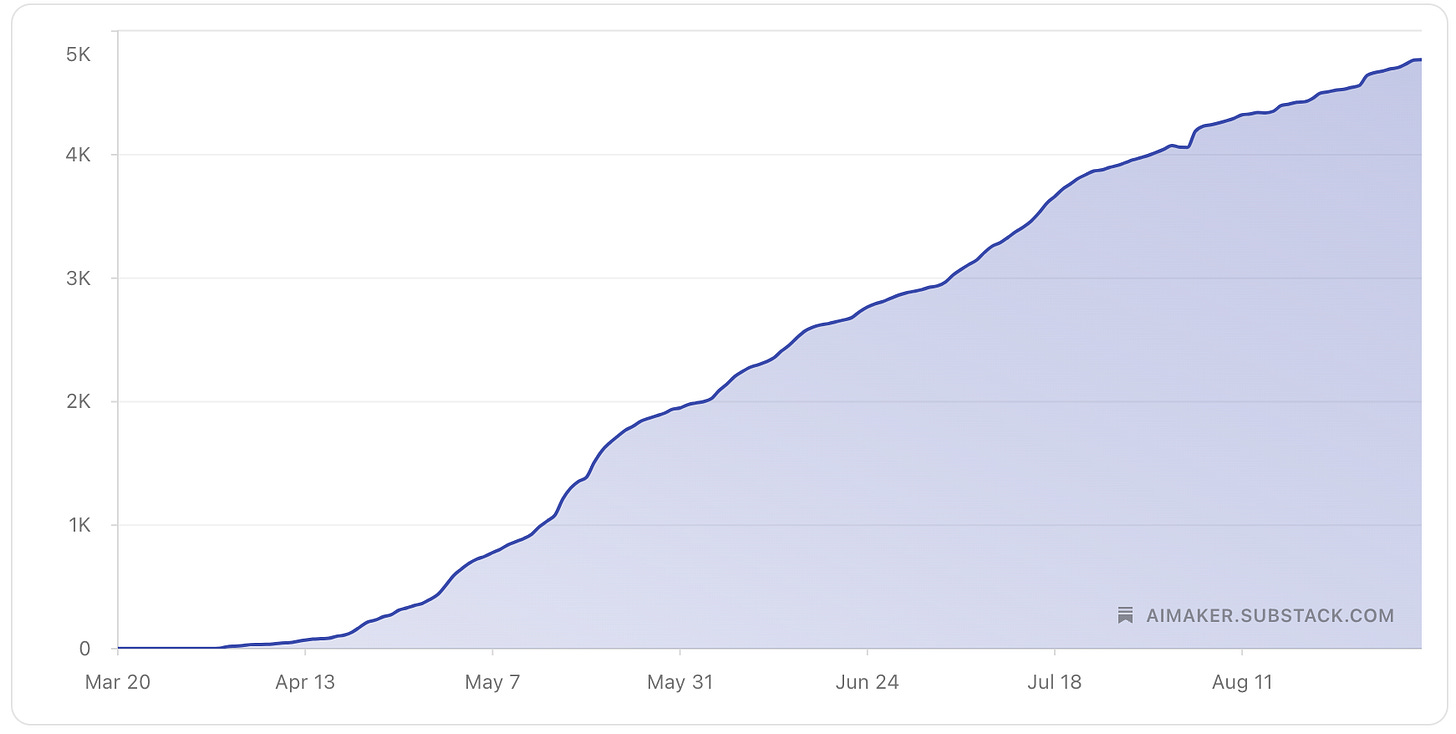

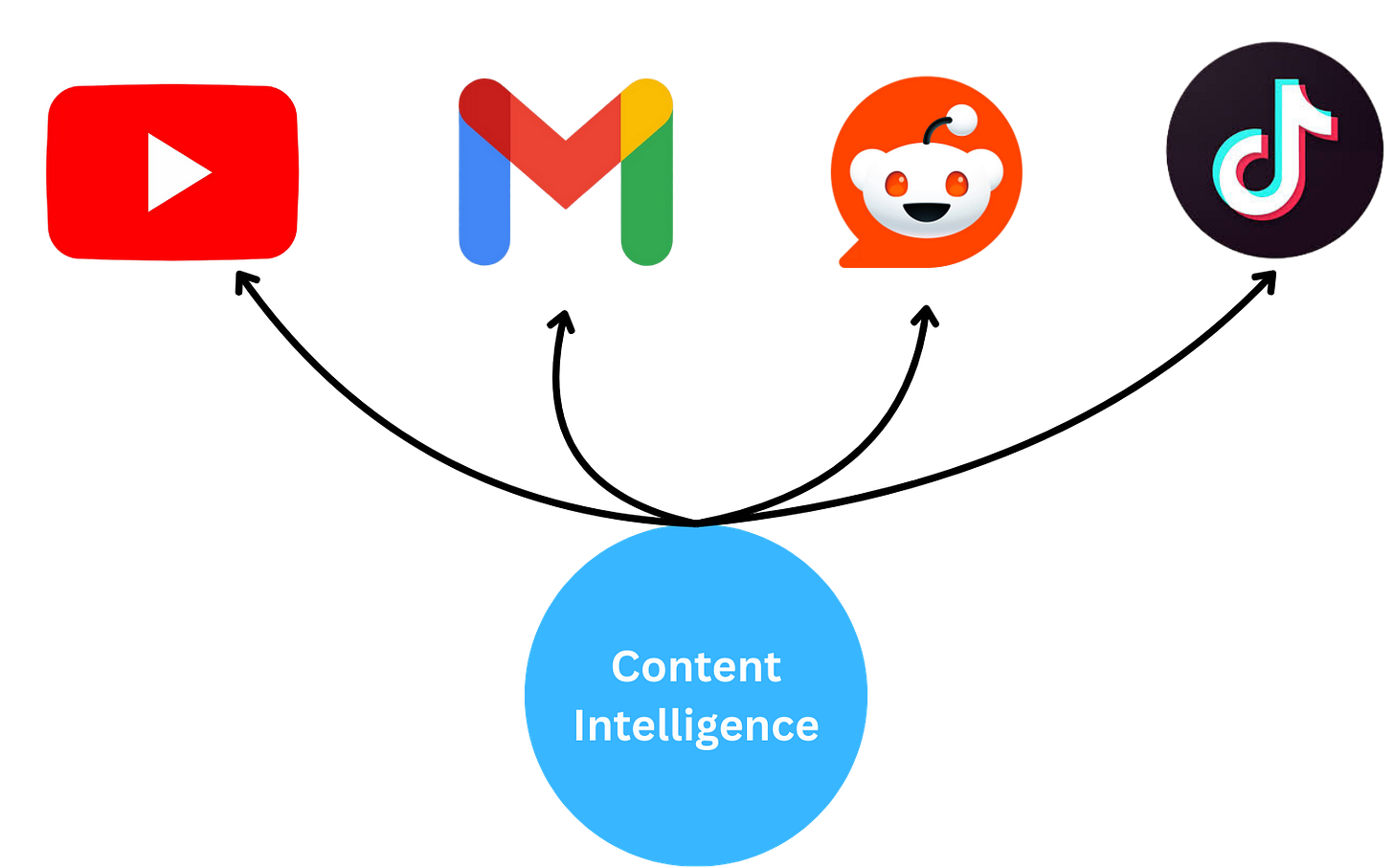
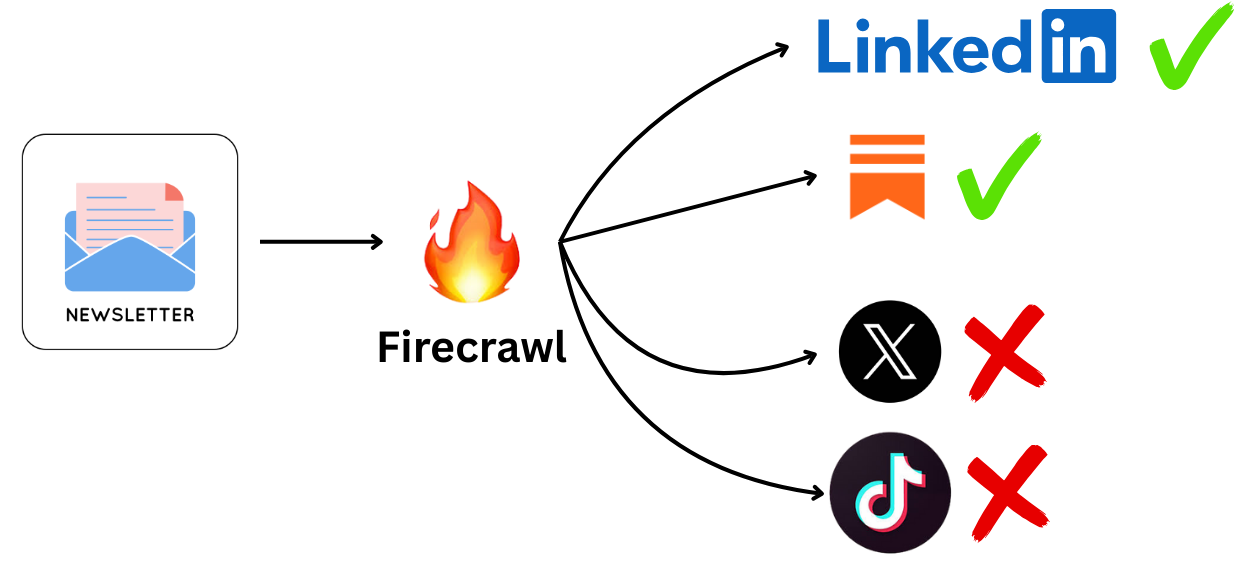
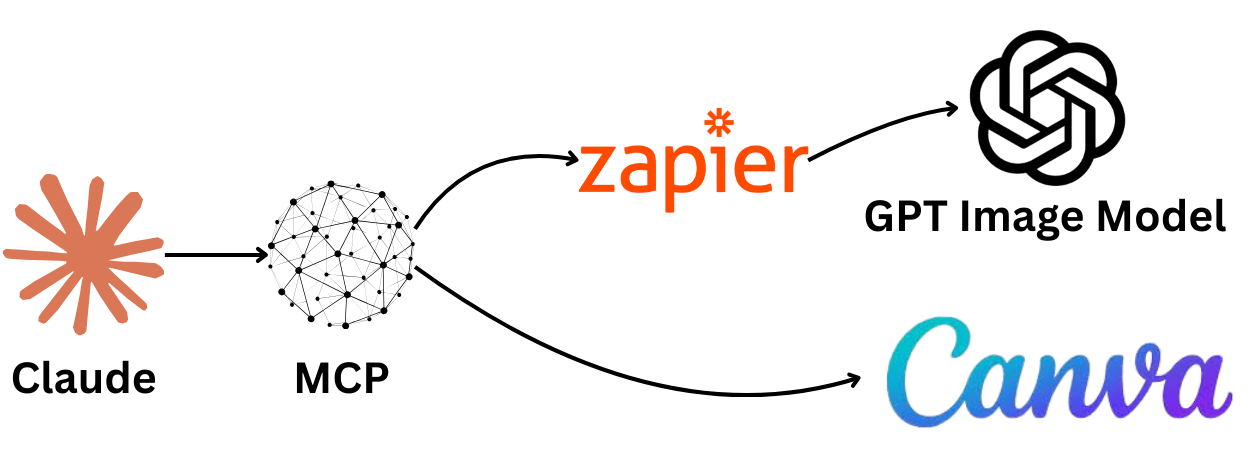
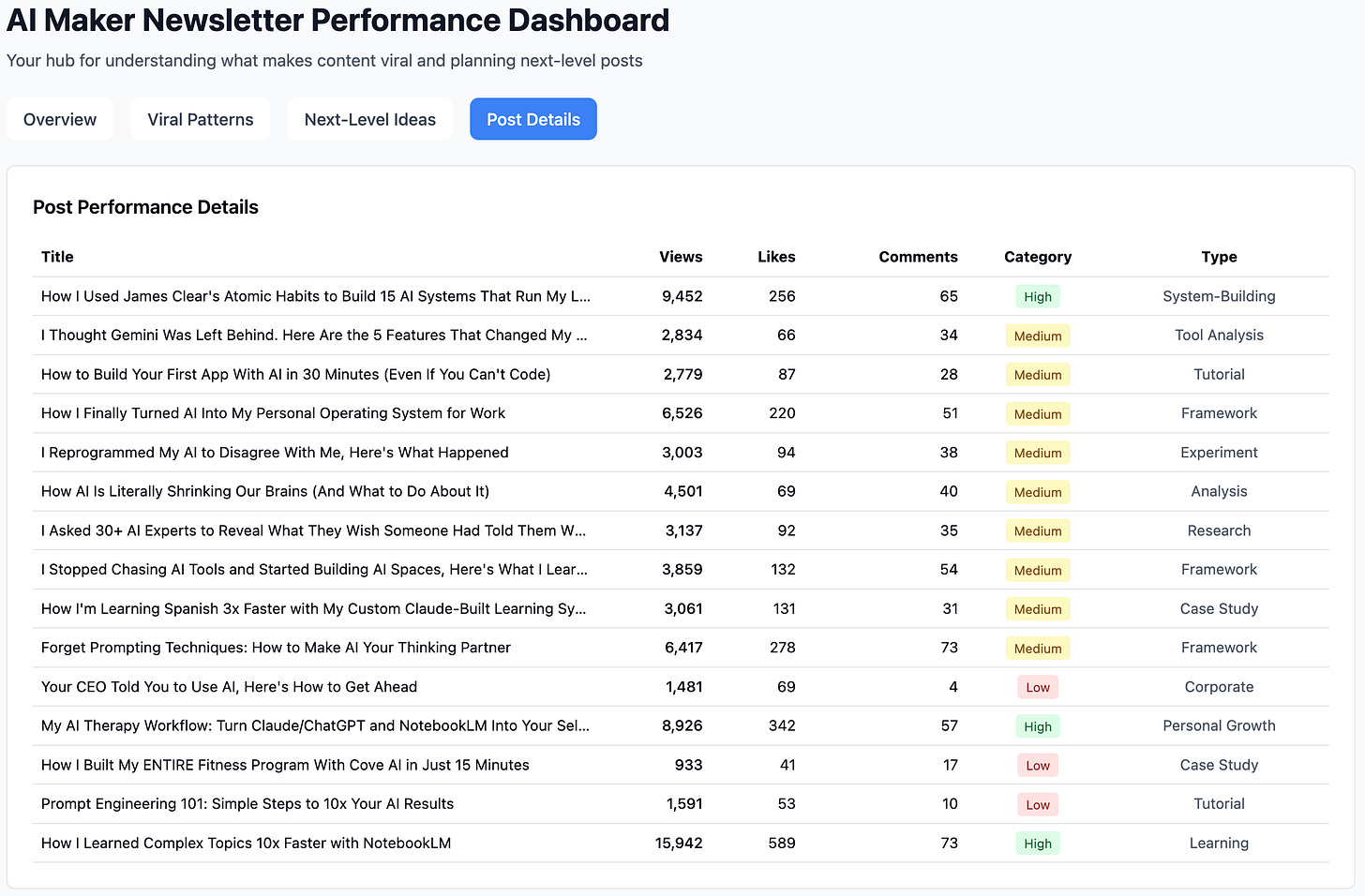

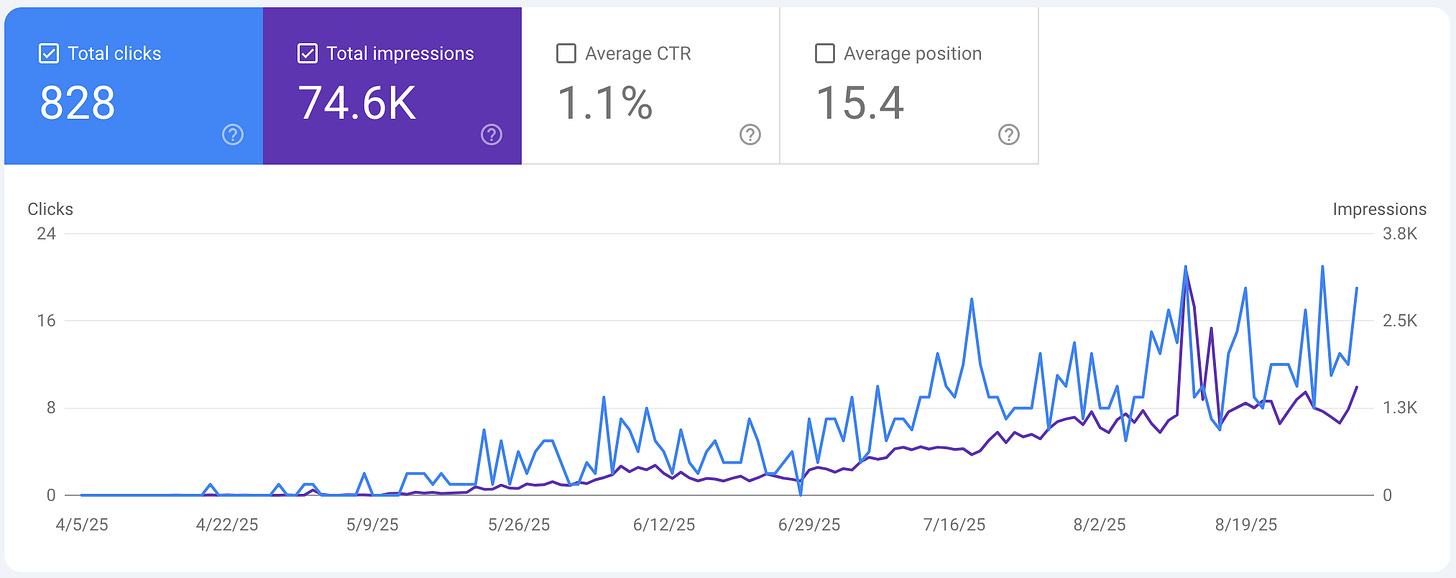
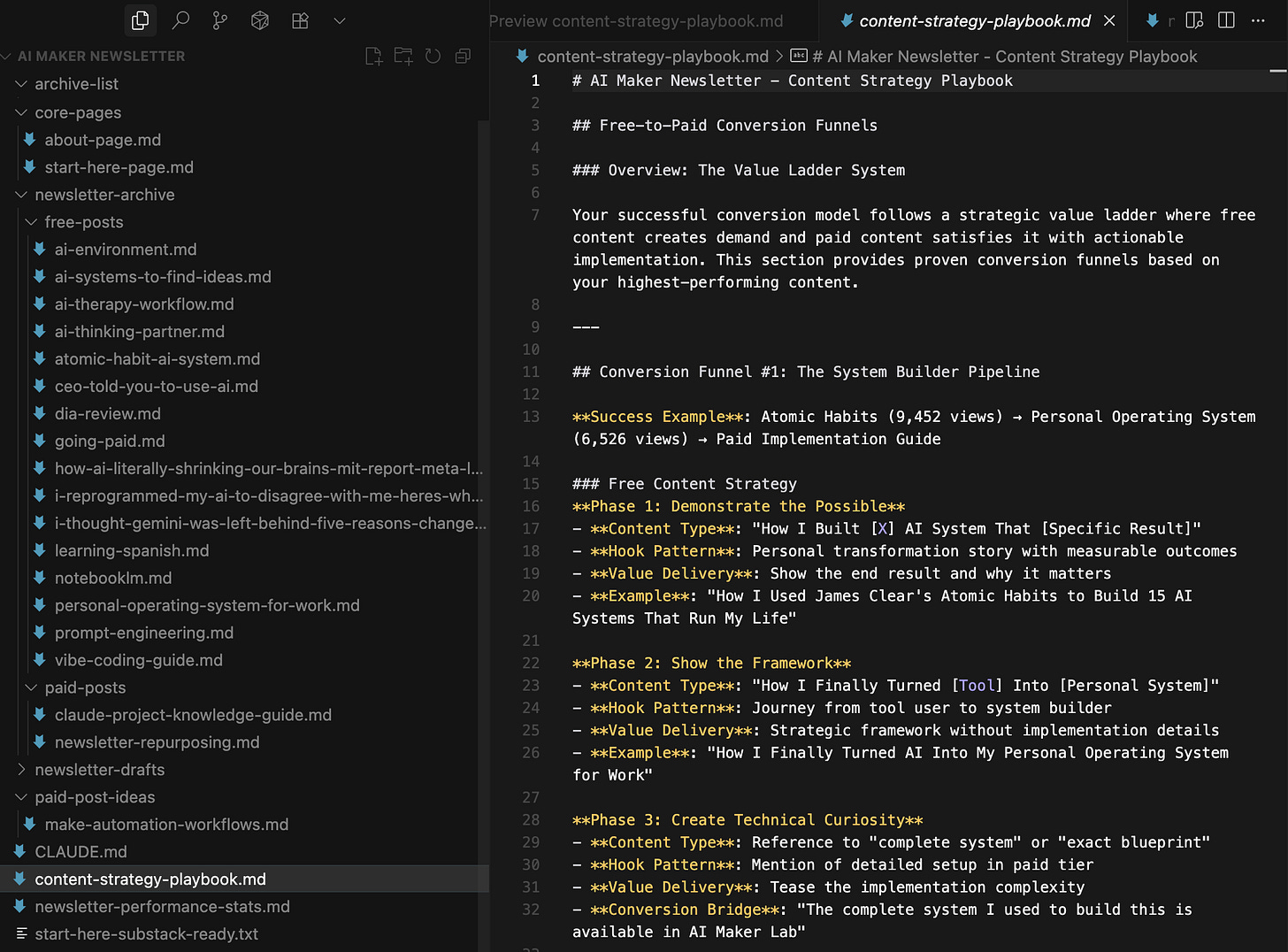
Love the systems you’re building, Wyndo! I approached some of them differently but with the same concepts in mind.
Really generous of you to share the secret weapons behind your process.
Such a helpful article